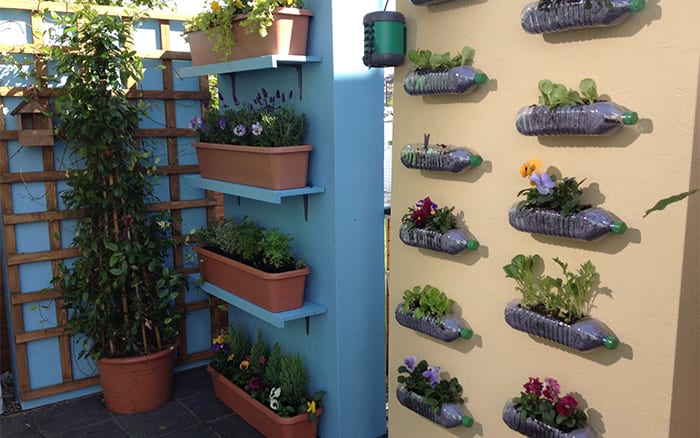I was back on ITV’s This Morning on Thursday with Eamonn and Ruth to show viewers my tips and tricks for great vertical gardens.
So many of us are pushed for outdoor space, especially if you only have a balcony. So why not grow plants up the walls instead? The shed, garage, side of your house… any space you can find.
Climbers
One of the simplest solutions is to use trellis to train a climbing plant up the wall. I chose evergreen Jasmine which has a lovely scent and year-round colour. You can even grow it from a pot if you don’t have any soil.
Gently train tendrils along and through the trellis supports, pointing them in the direction you want them to grow.
Window boxes
Window boxes are other popular way to grow plants in restricted space. But they don’t just have to be on windowsills – try installing shelves up a wall and put a window box on each one.
There are loads of things you can grow in them all year round. For autumn, try winter-flowering pansies and flowers like hellebores. You can even grow herbs and winter salad leaves. Mix them with evergreens like ivy and dwarf conifers for structure. Change your plants according to the season, so you always have a fresh and pretty display.
Plastic bottles
Recycled containers are cheap and easy alternatives to shop-bought pots. Try this cash clever idea by cutting out the top of some plastic bottles and screwing them to the wall. Fill with herbs, alpines, evergreens, bedding plants – anything you like!
Espalier
You can even use walls to grow your own fruit. Espalier is a French technique of training the branches of fruit trees to spread them out flat. They produce a lot of fruit in the summer and autumn, as well as stunning blossom in spring.
You can buy espaliered trees already trained. Apples and pears are popular choices and they need very little care.
Watering
Because the plants in a vertical garden are often in containers, they don’t have deep soil and the roots need help finding water. But if you don’t want to be watering every day, there are shortcuts.
Try a water slice, which is a disc of polymer that absorbs water like a sponge. Place a few pre-soaked ones in the container base before you plant it up, and they will retain excess water. This is then released into the soil if it starts to dry out.
You can also stand pots on top of water slices and allow the roots to take up the moisture. Or try adding polymer hydration crystals to the soil before you put the plants in. They act just like a water slice.
If you’re going away, try a water spike. It’s a nifty little device that clicks into the top of any water bottle. When you turn the bottle upside down and push it into the soil, the spike will release a steady dripping of water right to the roots.

If you’ve got a bit more cash to spare, invest in a watering system with an automatic timer. They usually have a pump and a few different hose tubes that are pegged to your containers. This connects to a timer on your tap which does all the hard work for you.


Leave A Comment